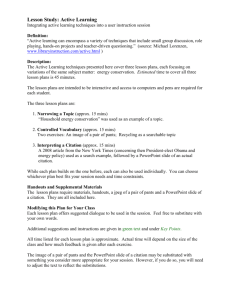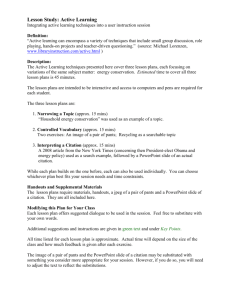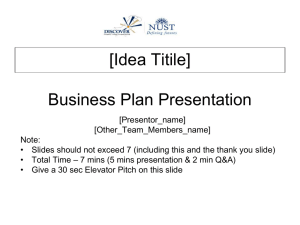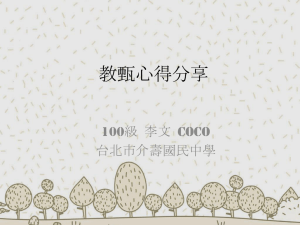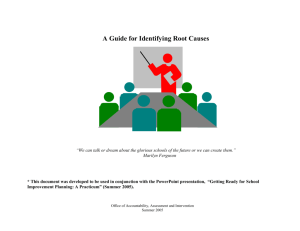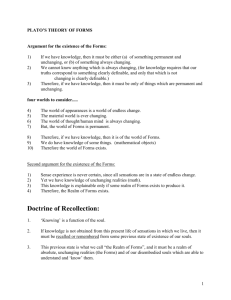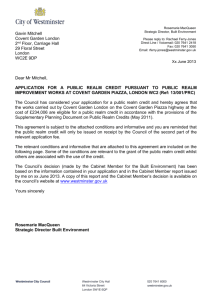Narrowing a Topic
advertisement
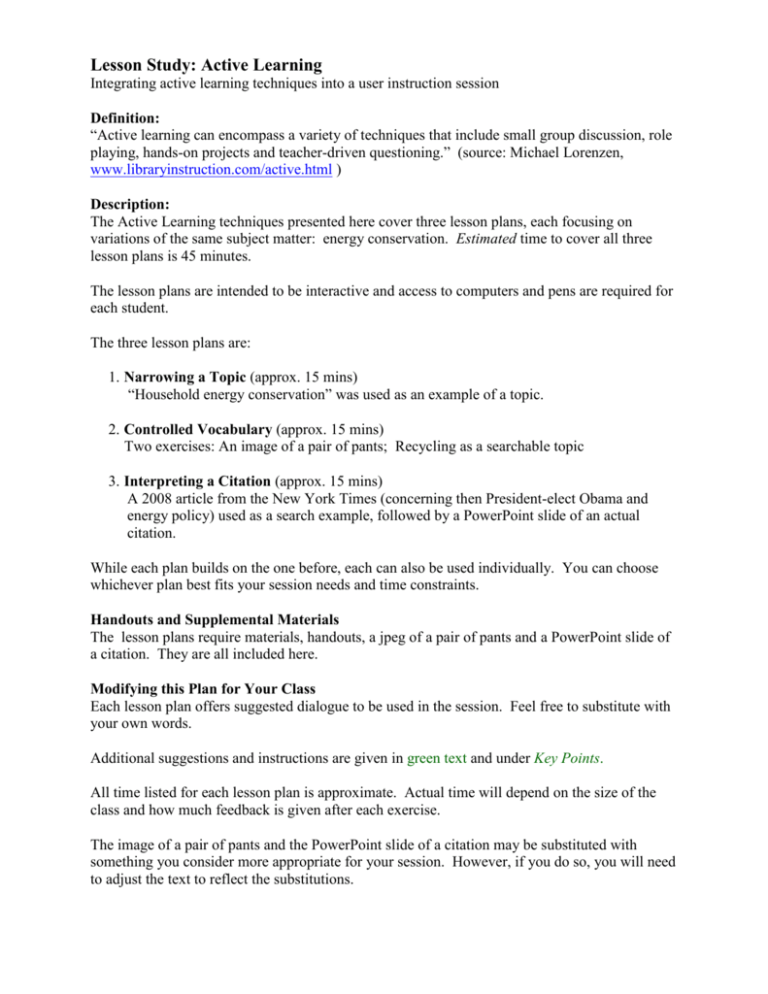
Lesson Study: Active Learning Integrating active learning techniques into a user instruction session Definition: “Active learning can encompass a variety of techniques that include small group discussion, role playing, hands-on projects and teacher-driven questioning.” (source: Michael Lorenzen, www.libraryinstruction.com/active.html ) Description: The Active Learning techniques presented here cover three lesson plans, each focusing on variations of the same subject matter: energy conservation. Estimated time to cover all three lesson plans is 45 minutes. The lesson plans are intended to be interactive and access to computers and pens are required for each student. The three lesson plans are: 1. Narrowing a Topic (approx. 15 mins) “Household energy conservation” was used as an example of a topic. 2. Controlled Vocabulary (approx. 15 mins) Two exercises: An image of a pair of pants; Recycling as a searchable topic 3. Interpreting a Citation (approx. 15 mins) A 2008 article from the New York Times (concerning then President-elect Obama and energy policy) used as a search example, followed by a PowerPoint slide of an actual citation. While each plan builds on the one before, each can also be used individually. You can choose whichever plan best fits your session needs and time constraints. Handouts and Supplemental Materials The lesson plans require materials, handouts, a jpeg of a pair of pants and a PowerPoint slide of a citation. They are all included here. Modifying this Plan for Your Class Each lesson plan offers suggested dialogue to be used in the session. Feel free to substitute with your own words. Additional suggestions and instructions are given in green text and under Key Points. All time listed for each lesson plan is approximate. Actual time will depend on the size of the class and how much feedback is given after each exercise. The image of a pair of pants and the PowerPoint slide of a citation may be substituted with something you consider more appropriate for your session. However, if you do so, you will need to adjust the text to reflect the substitutions. LESSON PLAN 1 Narrowing a Topic (15 mins) Materials needed: - Words on post-it notes - Blank post-it notes - Markers - Tape - Large blank sheets of paper - Handout – Choosing a Paper Topic You have been given an assignment to write a paper on any aspect of home energy conservation. Today in class you’ll learn some ways to narrow down the topic for that paper, how to find the words that will be most effective to use in searching for your topic, and how to interpret the citations that you find in your search results. We’ll start today by thinking about research topics. Specifically ways of thinking about the scope or realm of a topic, and methods of narrowing down or focusing to come up with a manageable topic for your paper. We will begin with a group exercise. Divide the students into groups the largest of which would include 4-5 people. Have each group gather by one of the large sheets of paper taped to the wall. Distribute word cards, blank cards, and markers to each group. You’ve been given a number of words related to the topic of household energy conservation. Now I’d like you to arrange the words in a way that helps you organize or think about the topic. Use most of the words in your packet, but you don’t have to use all of them. Arrange the words on the large sheet of paper and use the markers to indicate connections among the words, or to write additional words on the blank Post-its. This way you can illustrate connections, make your organization more complete, fill in gaps, or go in a different direction. You have (five) minutes to complete this task and then I’ll ask one (or more) of the groups to talk about your diagram and the thought processes you went through to create it. Remember there are no right or wrong answers. Give them at least three minutes, get their attention, and ask a group to report out. Depending on the time, ask other groups to report on issues not brought up by the first group. Looking at your arrangement of words, choose a piece of the larger topic that you would consider a reasonable-sized paper topic by circling the area. To help you choose, think of at least one research question that could be asked and answered around that subtopic in your paper. Write the research question or questions on your paper. Have the students sit in their seats and pass out the handout on Choosing a Paper Topic. This technique of modeling a subject could be helpful in choosing a research paper topic, whether you do it more formally or loosely, as you begin a potential topic. Representing a subject graphically can give you an idea of the context surrounding the larger topic and your narrower paper topic. It can also help reveal which topics might not work, for instance because they’re too disjointed, or would end up in frustration or a fragmented paper. Your paper may touch on areas outside your narrow sub-topic, but the bulk of it should focus on what falls within the boundaries of the sub-topic. The handout shows three possible ways of organizing concepts related to a topic that might be similar or different from what you did today. It also gives suggestions on other methods that could help you come up with a potential paper topic. Key points that should be mentioned if they don’t come out in the discussion: Specific paper and research topics exist within a larger universe of knowledge, and it’s important to understand and remember how your specific topic fits within that larger realm. This helps you to organize your paper as well as to keep in mind the research that has already been done within this larger realm. There are many ways of organizing the concepts within a larger realm. There is no one “right” way of doing this. There are also many ways of surveying the larger body of literature to find a paper topic that interest you and is the right size for your paper.
